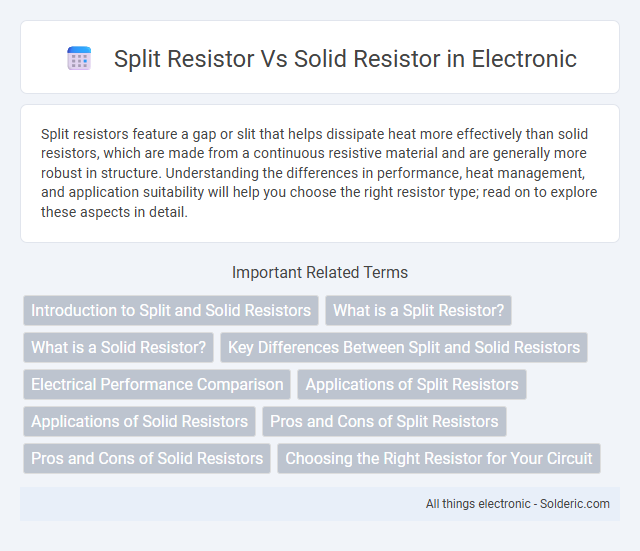Split resistors feature a gap or slit that helps dissipate heat more effectively than solid resistors, which are made from a continuous resistive material and are generally more robust in structure. Understanding the differences in performance, heat management, and application suitability will help you choose the right resistor type; read on to explore these aspects in detail.
Comparison Table
| Feature | Split Resistor | Solid Resistor |
|---|---|---|
| Definition | Resistor composed of multiple resistor segments separated by gaps | Resistor made from a continuous, uniform resistive material |
| Construction | Segmented, with intentional breaks or splits | Single-piece, homogeneous structure |
| Resistance Stability | Moderate, may vary due to split junctions | High, consistent resistance value |
| Power Handling | Lower, due to concentrated heat at splits | Higher, uniform heat dissipation |
| Applications | Used in precision voltage division, adjustable circuits | General purpose, current limiting, voltage regulation |
| Durability | Less durable; splits may introduce weak points | More durable and reliable under mechanical stress |
| Cost | Generally higher due to complex manufacturing | Lower cost, easier mass production |
Introduction to Split and Solid Resistors
Split resistors feature a resistive element with a gap or cut, allowing precise resistance while enhancing heat dissipation and stability under varying conditions. Solid resistors consist of a uniform resistive material, offering simplicity, durability, and consistent performance in applications requiring steady resistance. Your choice depends on the specific circuit requirements, such as precision and thermal management.
What is a Split Resistor?
A split resistor, also known as a segmented or multi-section resistor, consists of several resistive elements connected in series within a single package, allowing for better heat dissipation and voltage distribution. Unlike solid resistors that have a single continuous resistive film, split resistors reduce the risk of hotspots and enhance reliability in high-power applications. This design improves performance in precision circuits by minimizing inductance and thermal stress.
What is a Solid Resistor?
A solid resistor is a passive electronic component with a fixed resistance value, constructed from a continuous, homogeneous resistive material such as carbon film or metal oxide. Unlike split resistors, solid resistors offer improved stability, reliability, and precision due to the absence of physical gaps or separations in their resistive element. Understanding the properties of solid resistors helps you select the best option for applications requiring consistent resistance and durability.
Key Differences Between Split and Solid Resistors
Split resistors feature a visible gap or split in the resistive element, which allows for precise adjustment and customized resistance values, whereas solid resistors have a continuous, uniform resistive element designed for fixed resistance. The split design enhances heat dissipation and enables fine-tuning under load, making them ideal for calibration and test equipment applications; solid resistors prioritize stability and reliability in high-frequency circuits. Material composition differs as well, with split resistors often using metal film or wire-wound elements, while solid resistors typically employ carbon or metal oxide films for consistent performance.
Electrical Performance Comparison
Split resistors exhibit better heat dissipation and lower thermal noise compared to solid resistors, enhancing electrical stability in high-frequency circuits. Their segmented structure reduces parasitic inductance and capacitance, resulting in improved signal integrity and more precise resistance values under varying electrical loads. Choosing a split resistor can optimize Your circuit's performance by minimizing resistance fluctuations and electromagnetic interference.
Applications of Split Resistors
Split resistors are ideal for applications requiring precise resistance tuning and power dissipation control, such as in high-frequency circuits and voltage dividers. Their design helps minimize parasitic inductance, making them suitable for RF circuits and accurate measurement devices. Your projects benefit from enhanced thermal management and improved reliability when using split resistors in sensitive electronic components.
Applications of Solid Resistors
Solid resistors are widely used in applications requiring high stability and precision, such as in electronic circuits for voltage regulation, current limiting, and signal processing. Their uniform construction provides reliable performance in environments with varying temperatures and vibrations, making them ideal for aerospace, automotive, and consumer electronics. Your designs benefit from solid resistors' consistent resistance values and enhanced durability compared to split resistors.
Pros and Cons of Split Resistors
Split resistors offer improved heat dissipation compared to solid resistors, reducing the risk of thermal damage in high-power applications. They provide precise resistance values through multiple resistor elements in series or parallel, enhancing accuracy and reliability. However, split resistors tend to be bulkier and more complex to manufacture, leading to higher costs and potential installation challenges compared to solid resistors.
Pros and Cons of Solid Resistors
Solid resistors offer superior durability and stability under high temperatures, making them ideal for applications requiring long-term reliability and precision. They provide lower noise and better performance at high frequencies compared to split resistors, but their fixed resistance value limits flexibility in circuit tuning or adjustments. The main disadvantage of solid resistors is their susceptibility to damage from mechanical stress due to their rigid structure, which can lead to failure in environments with significant vibration or thermal cycling.
Choosing the Right Resistor for Your Circuit
Selecting the right resistor for your circuit involves understanding the differences between split resistors and solid resistors. Split resistors, often used for precision adjustments, provide finer control over resistance values, making them ideal for tuning and calibration in sensitive electronics. Solid resistors offer stability and reliability in fixed applications, ensuring consistent performance under varying temperatures and electrical loads.
split resistor vs solid resistor Infographic

 solderic.com
solderic.com